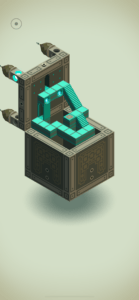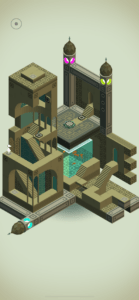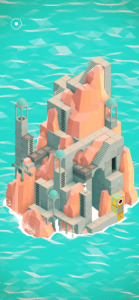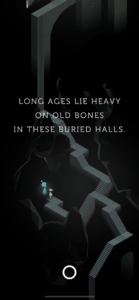Monument Valley 1 is a digital puzzle game developed by Ustwo and can be played on iOS, Android, and Windows platforms. The game developers didn’t have a specific target audience in mind but intended to make this game playable by people who don’t usually play games.
I argue that the puzzles in Monument Valley make use of intricate mazes that challenge players with impossible geometry, spatial rearrangement, diverse machinery to find the way out, bringing players the pleasure of exploring and discovering the interesting structure and unintuitive way of moving through each monument, the sensual pleasure of the unparalleled art design and sound effect, and finally learning about the embedded narrative that loosely links together the different puzzles on Ida’s journey.
As an example of “puzzles as the game”, Monument Valley centers around 10 levels of increasingly complex monuments (perception and interactive puzzles) which the player needs to help Ida the princess travel through. These monuments have all kinds of interesting spatial elements that defy the laws of physics, for example, two levels of different height can become connected after the player rotates the monument; in certain cases Ida can also walk vertically and on the ceiling. There are also gears that allow the player to move certain blocks, rotate the monument, and reveal hidden structures. These mechanisms of the puzzles and abnormal rules provide the player with the excitement of exploring the dynamic structure of the monument and understanding the optical illusions everytime they start with a new monument. To add in variety and increase the challenge of the puzzles, the game gradually adds in props like the Totem pole and obstacles like the crow people. The monument that impressed me a lot with its ingenious design was a puzzle box that can be opened in four different ways, each revealing a puzzle of a different color. Ida has to travel through these four different puzzles to light up the four towers, which then unlocks further structure in the box. In solving such puzzles, the players take pleasure not only in figuring out strategies to get out of the maze but also in uncovering the magnificent construction that the game has in store for them.


The puzzle box with an ingenious internal structure affords great fun of exploration and puzzle-solving.
Acknowledgingly, the puzzles, even the later ones, have pretty intuitive solutions and are relatively easy to solve. I often found my way out by randomly tapping and moving pieces without thinking. This may have to do with the developers’ intention of making the game playable by people who don’t usually play games. On the one hand, it makes the game accessible to a wider audience who do not necessarily know sophisticated game strategies. On the other hand, hardcore gamers can feel dissatisfied at the level of challenge of the game. However, based on my analysis above, the focus of the game is not simply on solving puzzles, but more on exploring the rules and transformation of the monument universe. One thing that I do think the game can improve upon is that the elements and types of obstacles can feel repetitive after having seen a few of those appearing again and again in different levels. The game developers should definitely consider increasing the variety of props and obstacles.
Additionally, Monument Valley distinguishes itself from other puzzle games with its incredibly gorgeous visual-audio design: A screenshot at any single moment in the game is like a piece of art. Each level has a unique color scheme and is set in a dreamlike environment, often alternating between bright and gloomy moods, sometimes amidst pinky clouds, sometimes in the depth of a dark dungeon. The artistic visuals are accompanied by ethereal and mystical music and sound effects. The sounds of harp strings and the echoes of gong when the player interacts with the monuments bring about a meditative ambience, which is reinforced by the unusually slow pace of the game, creating a sensually and psychologically unique aesthetic experience.

The unparalleled art design is a highlight of the game.
Lastly, Monument Valley has an embedded narrative element that is mainly told through a blue apparition and some animations in between levels and at the end. A story about Ida solving all the monument puzzles and breaking the spell that transformed colorful birds into black-and-white crows, this narrative provides some context and motivation for the characters in the game. Despite unifying the puzzles under a single theme, I don’t think the narrative adds anything important to the game experience. This is understandable since the narrative is never the major attraction of the game, though a narrative that could tie better to the puzzles would deepen the game motif and make the puzzles more immersive and engaging.

The narrative is told through a blue apparition.



